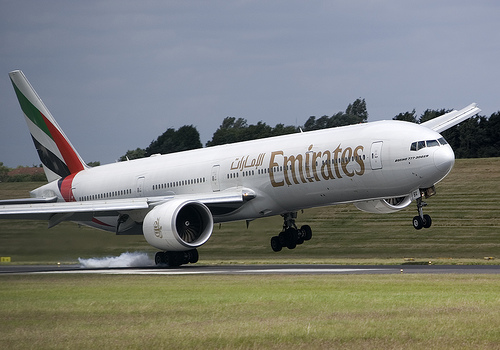We’ve all had the thought cross our mind while flying, “What if the pilot(s) somehow became incapacitated and I had to land this thing? What would I do?” Or maybe more timely for today’s world, “What if a terrorist takes over the plane and I have to save the day by knocking him out with a Chuck Norris-style thump to the head?”
You’re a hero, boo-yah! But, if the pilot’s unconscious, you may have to get the plane on the ground. Relax, it’s not as hard as it looks and if you follow a few simple steps you’ll be on the ground safely and in one piece for your press conference and hero shots.
Maintain Aircraft Control (Straight and Level)
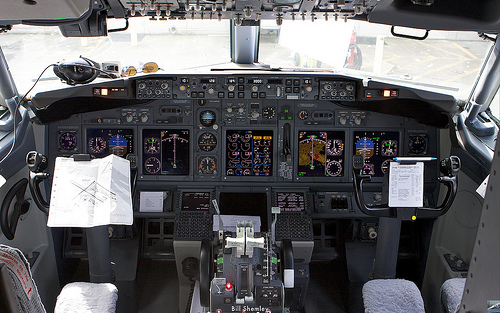
When you first arrive in the cockpit take the left seat if possible; this is generally where the Captain or Aircraft Commander sits and often has easier access to some of the instruments you’ll need to fly. However, the majority of dual-seat aircraft can be flown from either side.
As soon as you sit down take a deep breath and look outside to see if the aircraft is in a dive (you see more ground in the windscreen than sky), climb, turn, etc. If it appears to be straight and level then don’t touch the flight controls, the autopilot is most likely on and there’s no need to interfere. If, however, the airplane is racing towards the ground or in a steep turn, then you need to use the stick or yoke (pilot speak for steering wheel) to bring it back to wings-level flight. Just like in the video games, you pull back on the yoke to make the airplane climb, push forward to make it descend, and turn it right or left to turn.
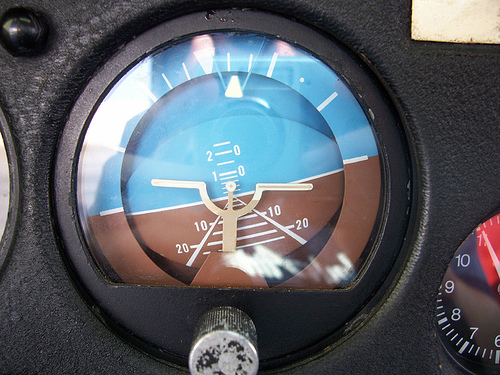
If you are in the clouds and can’t tell the attitude of the aircraft (that is, its relation to the horizon), then it will be necessary to use the attitude indicator, also referred to as the artificial horizon. This is an instrument that gives a representation of the aircraft in relation to the ground and sky. If you’re on a jet of some sort, chances are high that it will be displayed on the screen directly in front of you. The “w” shape in the middle represents the wings of the aircraft, the brown represents ground, and the blue represents sky. So if you see half brown, half blue it means you are in level flight which is what you want. If you see anything else, then make corrections with the stick as necessary to line up the wings of the aircraft with the horizon line.
Make a Radio Call

After you have the aircraft under control, the next step is to contact Air Traffic Control (ATC) over the radio to explain the situation and ask for help. The majority of aircrafts have a radio mic switch on the yoke on the back where your index finger would rest when you grasped it normally. The problem is that the autopilot disconnect switch is often placed on the yoke as well and without proper knowledge of the autopilot system, an inadvertent disconnect of the autopilot could result in a major disaster. A safer alternative is using the hand-held radio normally mounted to the left of the pilot’s seat just below the side window. Use it just like you would use a CB radio, push to talk and release to listen.
Try making a call on the radio frequency currently selected and see if you get a response. Say “Mayday” and state who you are and what has happened. Don’t worry about radio etiquette, it’s an emergency so just use plain English and tell them you don’t know what you’re doing and need some help, but don’t sound too panicked. You’re a man after all, and completely in control of the situation.
After talking, remember to release the mic button to listen. If no one responds, try changing the VHF radio frequency to 121.5 MHz (this is known as “Guard” and is monitored by everyone). The radio unit will normally be located on the center pedestal in between the pilot’s and co-pilot’s seats or directly in front of you on the center panel.
Do What They Tell You
Just like in the movies, what happens next is that various agencies will be notified of your emergency and they will find someone who is an expert for your plane to walk you through getting it on the ground. They will know the cockpit layout and be able to tell you where a button or switch is located and what you need to do with it. They will also be working in conjunction with ATC to navigate you to an airport where you will be able to land. As long as you follow their instructions to the letter everything should turn out just fine. You may not have the prettiest landing, but you’ll survive.
Get It on the Ground
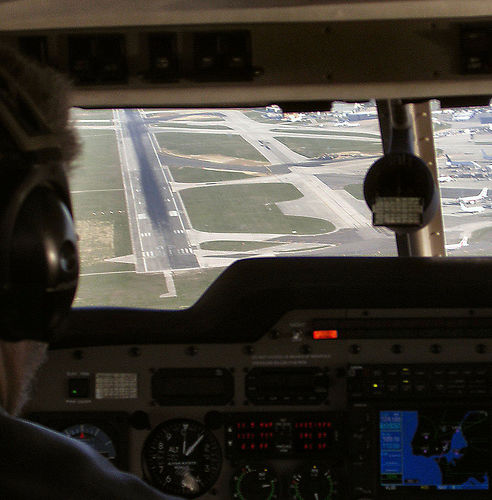
The reality is that many of today’s jets are fully-automated and have the capability to land themselves or at least get you lined up on the runway center line on a proper glide path so that you can take over at 50-100 feet off the ground. All you will have to manually do is:
- Flare (pull up slightly on the stick just prior to touchdown so the main gear hit first)
- Fly the nosewheel to the ground (push the stick forward until the front touches down)
- Pull the throttles all the way back
- Step on the brakes, which are located on the tops of the rudder pedals down by your feet.
- If you find yourself veering off the runway, lightly step on the rudder pedals to steer yourself back to centerline
Notes, Warnings, Cautions

You’ve landed! It’s incredible; you’re now the hero of the day, congratulations! Now before you go patting yourself on the back in your imaginary scenario, here are a few additional things to consider:
- Getting the landing gear down before landing is obviously a key part of the process, but has been forgotten by countless pilots. The gear handle is almost always located just to the right of the center console on the front instrument panel, basically just above the left knee of the co-pilot if he were sitting there.
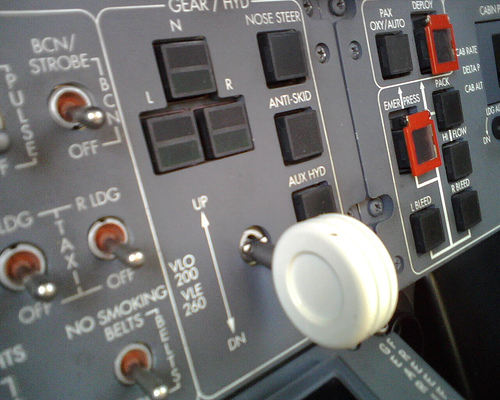
- In order to slow the aircraft to land you must employ various drag devices such as slats (normally only in very large aircraft) and flaps. These allow the airplane to maintain lift at slower airspeeds and allow you to keep the attitude level during a descent. These are generally found right next to the throttles.
- Slats, flaps, and landing gear all have a max speed at which they can be deployed. It’s not the end of the world if you overspeed them in an emergency situation, but it should be avoided. If you aren’t in communication with someone that can help, look on the dash for a placard with the speeds, or a card with TOLD (takeoff and landing data).
- If you can find the airspeed indicator make sure that you keep it within the green arc while flying. Just like anything in life, green is good, yellow means caution and red means dead. If you get too slow you will lose lift and stall the aircraft (trust me, this is bad and if you’re not a pilot, you probably won’t make it).
- If you’re flying a commercial jet like a 737, a good rule of thumb is to keep it flying at about 200 knots if you don’t have flaps or gear extended, and 130 knots once you do and are making the approach to land. A smaller plane like a Cessna is stable on approach at speeds closer to 70 knots. Of course, if you’re talking to ATC ask them how fast you should go and they’ll hopefully be able to tell you.



